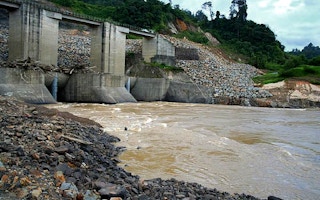The outcome of elections in Malaysia’s key state of Sarawak on Friday could determine how soon the country’s long-delayed Bakun hydroelectric dam starts generating power and fuelling economic growth.
A strong win for Prime Minister Najib Razak’s ruling coalition could provide him with a fresh impetus to execute economic reforms, including the dam which has been delayed following almost two decades of controversy over its environmental impact, cost overruns and allegations of displacement of indigenous communities.
Following are some key facts on the dam:
- Bakun, one of the world’s tallest dams, seals off the Batang Balui river in Sarawak on Borneo island. Once filled, it will cover 70,000 hectares of primary and secondary forests, roughly the size of Singapore.
- Construction costs have doubled to at least $2.6 billion from initial estimates, making it the fourth most expensive building job in Malaysian history.
- The 2,400-MW Bakun dam, owned by the state government, was meant to supply power to peninsular Malaysia via an undersea cable but the plan was scrapped as costs were prohibitive and would drag on future earnings for state-run energy firm Tenaga Nasional.
- The dam is now intended to drive a 30-year development project to attract power-intensive industries to Sarawak and boost its GDP to 118 billion Malaysian ringgit ($39 billion) in 2030 from 93.4 billion ringgit in 2010.
- The government has made three attempts to build the dam. The idea was conceived in the 1970s but the plan encountered setbacks during an economic slowdown in 1985-87 and the Asian financial crisis in 1997-98.
- Parts of the dam collapsed more than 20 times in the second construction attempt, which local media attributed to the wrath of restive local spirits. The contractors reportedly slaughtered six pigs and built a shrine to appease the spirits.
- More than 10,000 indigenous people were relocated from the catchment areas to a nearby town of wooden shacks to accommodate construction of the dam. Tribal leaders say the government allocated inferior agricultural land to the communities and gave little compensation, charges which the authorities have denied.
Why is Bakun dam important?
Bakun dam coming onstream will bring Rio Tinto a step closer to building a $2 billion aluminium smelter in Sarawak with local firm Cahya Mata Sarawak . China’s main power grid operator also plans to invest $8 billion in an aluminium smelter and two dams in the state.
It could also give fresh impetus for Australian manganese producer OMH Holdings , chemical maker Tokuyama Corp and China’s top aluminium group Chinalco to commit to their announced investments in Sarawak.
Bakun will be able to harness one of its eight turbines to commercially generate 330 MW of electricity by July and help power an existing 60,000 tonne per annum aluminium smelter owned by Malaysia’s Press Metal .
Why is there a delay in setting power tariffs?
Sarawak Chief Minister Taib Mahmud has said Bakun will be a joint-venture between the state and federal governments, but there has been a disagreement over power tariffs.
The federal government had wanted to sell electricity to the state’s power firm Sarawak Energy for 0.09 ringgit per kilowatt-hour (KwH) over 30 years.
Sarawak Energy wanted to settle at 0.05 ringgit to 0.07 ringgit per KwH to secure investments from smelters for whom energy accounts for a third of costs.
Sarawak’s request for lower tariffs was based on the view that power uptake will be slow and the federal government needs to subsidise power costs to support economic growth in the state, a key vote bank for Prime Minister Najib Razak.
How will the Sarawak poll outcome affect Bakun?
If Najib’s ruling coalition keeps its two-thirds majority in Sarawak, he can push through economic reforms and the federal government may stick to its high power tariff proposal in order to lower debts and prevent more subsidy payments.
If the ruling bloc loses more seats to the opposition and ends up with a simple majority in the state, Najib has to rebuild support by agreeing to subsidise power tariffs. ($1 = 3.02 Ringgit)










